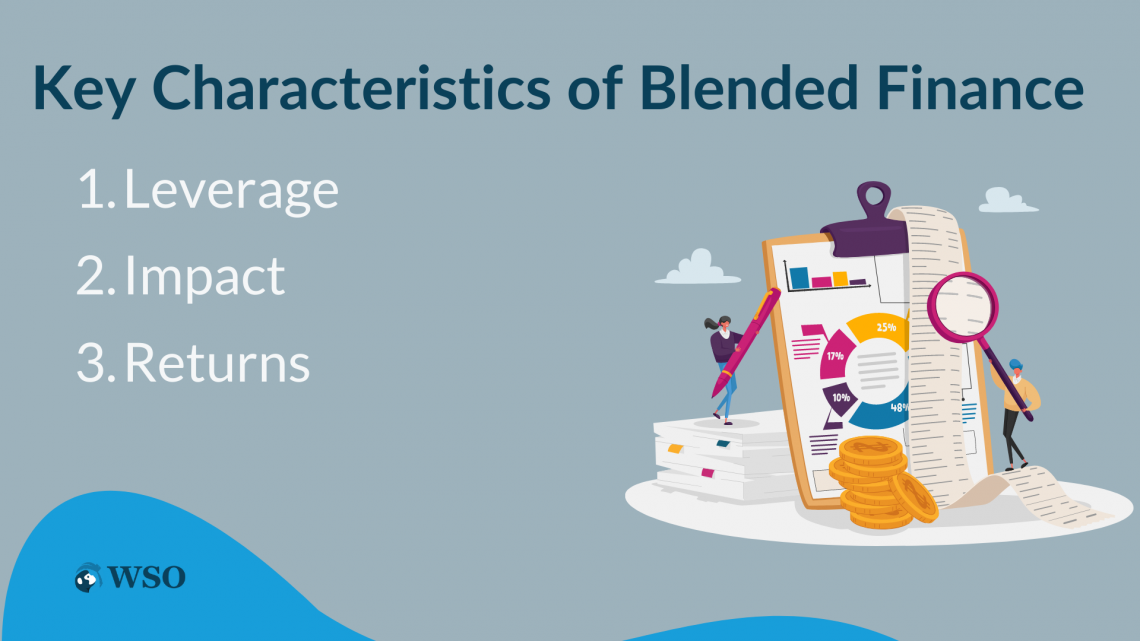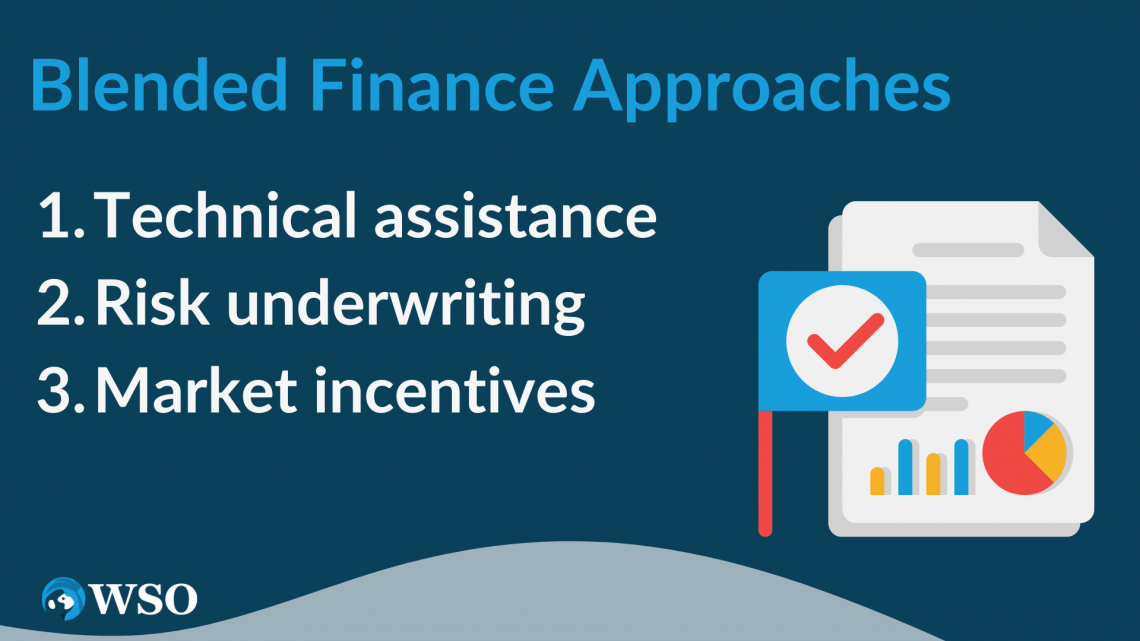Blended Finance
Blended finance combines public and private sector funds to support sustainable development projects, leveraging different types of capital for greater impact.
Blended finance is a comparatively new concept to the world. According to The Addis Ababa Action Agenda, it stands for financing that uses a combination of concessional public finance and non-concessional private finance along with expertise from the public and private sectors.

In the words of OECD-DAC, the strategy's use of development finance to mobilize additional finance towards SDGs in developing countries is called blended finance.
This concept runs on the basis that the use of funds will eventually benefit both investors and communities. It will also be beneficial to scale up commercial financing for developing countries and to direct the funds to good causes.
Owing to these reasons, it is designed to provide aid to fulfill sustainable development goals (SDGs), as stated by the United Nations.
As of 2017, an additional $2.5 trillion is required to meet the SDGs yearly and an additional $13.5 trillion to execute the COP21 Paris climate accord.
There was a survey that was done under the supervision of the World Economic Forum, owing to which OECD released a few findings.
The concept was first introduced to recover the funding gap by raising the needed private financing.
There are 111 developing countries in which a whopping $60.2 billion have been invested by over 180 blended finance funds and facilities and they have impacted over 177 million lives.
This greatly boosts the sustainable development goals agenda and the development of developing countries.
This has been gaining a lot of popularity among the common folks and in international development finance.
Therefore, the Development Assistance Committee, or the DAC, has developed principles to propagate the cause meaningfully.
Now let us move on to the key characteristics of blended finance.
- Blended finance is a very new concept to the nations and they are trying to incorporate it as efficiently as they can.
- So far, there are 111 developing countries in which a whopping $60.2 billion have been invested by over 180 blended finance funds and facilities and they have impacted over 177 million lives.
- The three main characteristics of blended finance are leverage, impact, and returns associated with it.
- There are three ways to approach this concept: technical assistance, risk underwriting, and market incentives that we have covered briefly in the article.
- We have two sets of principles defined by DFI and OECD-DAC. These are some of the pre-written principles that the nations involved must abide by.
Key characteristics of blended finance
It is obvious that on such a big scale, more public resources are needed to meet the SDG requirements.

This measure has been increasingly crucial for the environment's welfare and the world at large. More often than not, funds circulated at large-scale investing opportunities always come with higher economic incentives at the cost of environmental degradation.
Therefore, one of the important challenges for SDG is to know how to channel these funds from private sources and divert them to the sectors and countries that play a pivotal role in the SDGs and other major development goals surrounding it.
More and more people, investors, and institutions are getting attracted to emerging and frontier markets. This will only benefit development funders facing funding challenges related to these issues.
And thus, there has been an increase in more public-private collaborations that are successful at all levels and have turned out as a great opportunity for investors and financiers to develop more such strategic moves.
Overall, this concept can be represented by the three main attributes. They are listed below:

1. Leverage
This means boosting the capital leverage and extending the reach of the restricted development finance and philanthropic reserves to utilize them strategically to foster a greater development influence for overall growth.
2. Impact
The synergy created by the partnership of public and private resources at hand could increase the impact many folds in terms of investment funds acquired, skill sets, effectiveness, and efficiency of the structure.
3. Returns
The returns that these investments could yield would be risk-adjusted in the sense that the returns will not largely deviate from the market expectations of the private investors.
These are the three pillars of Blended Finance.
Blended Finance Approaches
There are three main approaches covered under blended finance. These are technical assistance, risk underwriting, and market incentives.

1. Technical assistance
This tool is one of the essential tools that could be used to acquire private investments into various development projects and create awareness, thus leading to new projects.
There are many advantages of technical assistance like greater project liability, better investment outcomes due to better investment performances, better knowledge to everyone, increased efficiency of local markets, etc.
2. Risk Underwriting
This is used to improve the companies' credibility and assure investors that their investments will be recovered when the time arrives, or they will at least be able to absorb certain small losses if they occur.
Two of the common types of tools under risk underwriting are insurance policies and guarantees. An insurance policy, as we know, is a contract issued by a third party that guarantees payment if it defaults with the occurrence of any particular event or so.
However, a guarantee is a formal assurance that the guarantor will take responsibility in case of any undesirable event.
These types of issuance secure the investors' funds and assure them that they will receive at least a minimum amount on their investment if there is any default.
Other forms of risk underwriting, namely currency hedges and interest rate swaps, are used to shield one's investment from volatility in the market and save one from potential losses.
3. Market incentives
Market incentives assist in investing in high-impact sectors where the normal market fundamentals are out of the picture. These kinds of markets require a lot of innovations in terms of products and services that ultimately help achieve development goals.
This can also provide certain visibility to the investors regarding the revenue and pricing of these products to develop new markets.
Principles of Blended Finance
There are two sets of principles formed by different entities. Let's discuss the DFI-enhanced principles first.

1. DFI enhanced principles for blended concessional finance in the private sector private
This set of principles was established by the agreement of the DFI Working Group in October 2013 with the objective of the maximum utilization of concessional resources in private sector projects.
The updated edition was released in October 2017 with guidelines for every principle.
These guidelines discuss the importance of concessional finance to achieving goals.
The five core principles from the 2013 report are as follows:
- Principle 1: Additionality/rationale for using blended concessional finance
- Principle 2: Crowding-in and minimum concessionality
- Principle 3: Commercial sustainability
- Principle 4: Reinforcing markets
- Principle 5: Promoting high standards
2. OECD-DAC blended finance principles for unlocking commercial finance for the sustainable development goals
These principles were approved on 31 October 2017 during the DAC high-level meeting, serving as the guiding policy for all the development finance providers and ensuring a common framework to avoid miscommunication and misunderstanding.
These principles provide blended finance with accepted quality standards and the level at which it should create impact.
These five principles are as follows:
- Principle 1: Anchor blended finance use to a development rationale
- Principle 2: Design blended finance to increase the mobilization of commercial finance
- Principle 3: Tailor blended finance to local
- Principle 4: Focus on effective partnering for blended finance
- Principle 5: Monitor blended finance for transparency and results
Blended Finance Conclusion
Looking ahead with this initiative, many development finance institutions (DFIs) are constantly aiming to increase their potential to provide blended finance and to fill the knowledge gap among investors and institutions by introducing a standard framework for better understanding.

They play a crucial role in implementing blended finance in cooperation with the private sector in the market by assuming a leadership role. This endeavor requires all the included and responsible nations to contribute their efforts and funds for a long and sustainable future.
Governments of these nations should also take individual responsibility in their homelands to strive to fulfill even the bare minimum actions on their part to create a nation-level impact on their behalf.
With the coming times, sooner or later the nations will have to compromise more if they do not start small today as the resources are being compromised every day and their demands are increasing endlessly.
Consequently, the nations, alone and together, must strive to achieve sustainability for a better world and to leave a legacy as good as our ancestors.
Thus, to capitalize on this concept, a common base or foundation is the first step that DFI takes care of.









or Want to Sign up with your social account?